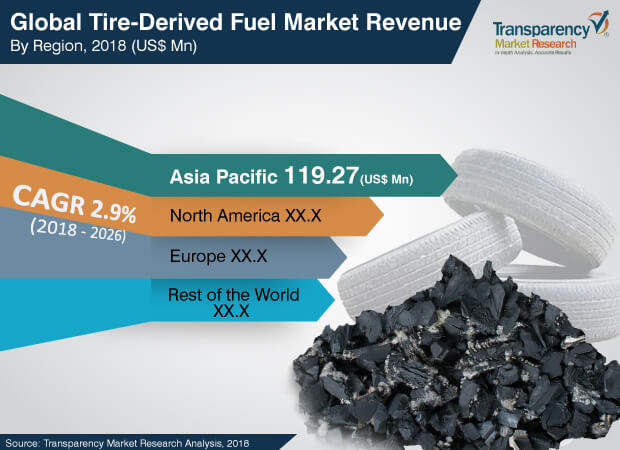
Tire derived Fuel Market – Snapshot
Tire-derived fuel (TDF) is fuel derived from all kinds of scrap tires. It may include whole tires or tires processed into uniform, flowable pieces that satisfy specifications of end-users. Industrial facilities across the world, including cement kilns, pulp and paper mills, and electric utilities, use TDF as a supplemental fuel to increase boiler efficiency, decrease air emissions, and lower costs.
Tire-derived Fuel is an Alternative to Other Solid Fuels
Fuel derived from waste tires, including altered, shredded, or whole tires, is known as tire-derived fuel (TDF). According to the U.S. Environmental Protection Agency (EPA), when burned, tires generate the same amount of energy as oil; 25%–50% more energy than coal, and 100%–200% more energy than wood. Moreover, the EPA and state-testing facilities have shown that TDF produces low emissions compared to other conventional fuels. At well-controlled facilities, emissions are considerably less when TDF is used to replace some of the typical fuels used at the facilities. As a result, the EPA has recommended the use of tire-derived fuel as a viable alternative to the use of fossil fuels. Hence, facilities such as utility boilers, cement kilns, and pulp & paper mills use TDF as a supplemental fuel in their energy-intensive processes. There are several other benefits of using tires as a fuel:
Request PDF Brochure :https://www.transparencymarketresearch.com/sample/sample.php?flag=B&rep_id=37274
- Use of TDF reduces the amount of fossil fuels that would otherwise be consumed
- TDF is less expensive than fossil fuels
- Diversion of tires from landfills reserves landfill capacity for other municipal waste and helps prevent scrap tire piles
These factors are driving demand for tire-derived fuel.

REQUEST FOR COVID19 IMPACT ANALYSIS :https://www.transparencymarketresearch.com/sample/sample.php?flag=covid19&rep_id=37274
Low Recovery Rate in Developing Countries
Around one billion scrap tires are generated and an additional four billion are stockpiled across the world every year. Tire landfills are undesirable, as they become breeding grounds for mosquitoes and other disease-carrying pests. It is also common for these landfills to catch fire and release thick toxic smoke. Moreover, the global tire industry is expected to expand rapidly in the near future, with Asia Pacific accounting a major share of the rise in demand in 2017. In certain developed economies, the end-of-life recovery rate for tires is normally high. However, this is not the case in developing countries in Asia, Africa, and the Middle East due to lack of infrastructure and minimal government regulations. According to the World Business Council for Sustainable Development, every year, the U.S. and the EU dump 14% and 16% of their scrap tires into landfills, respectively, whereas more than 50% of tires go to landfills in Saudi Arabia, Russia, Ukraine, and Argentina. In Asia, end-of-life tires are routinely disposed off in landfills or by using other methods such as burning, which have a harsh impact on the environment. This low recovery rate in developing countries of Asia is likely to hamper the market in the region during the forecast period.
Explore Transparency Market Research’s award-winning coverage of the global Industry:
https://www.prnewswire.com/news-releases/increasing-preference-towards-high-protein-diet-that-is-ready-to-go-is-fueling-growth-of-global-meat-extract-market-valuation-to-reach-us-2-5-bn-by-2029–transparency-market-research-301003674.html
Increase in the Production of Automobiles
The global automotive industry is expanding at a rapid space, particularly in Asia Pacific. Government, corporate, and personal vehicles are increasing in number at levels much higher than ever before. Due to a large population, abundant availability of raw materials, and low cost of labor in Asia Pacific, several automobile giants are moving their manufacturing plants to the region. Furthermore, microeconomic development, effective and efficient vehicle-manufacturing techniques, and rise in the number of middle-class consumers are propelling vehicle sales. Additionally, rise in popularity of electric vehicles in North America and Europe provides a boost to vehicle sales. These factors are projected to result in an increase in the amount of scrap tires in the next few years. Several governments across the globe are using the concept of ‘Reduce, Reuse, and Recover’ (3R) for scrap tire management due to various advantages. Moreover, with fossil fuel prices increasing rapidly, the demand for cheap alternatives such as tire-derived fuel is on the rise. This is estimated to present growth opportunities to the tire-derived fuel market in the near future.
About Us:
Transparency Market Research is a global market intelligence company, providing global business information reports and services. Our exclusive blend of quantitative forecasting and trends analysis provides forward-looking insight for thousands of decision makers. Our experienced team of Analysts, Researchers, and Consultants, use proprietary data sources and various tools and techniques to gather, and analyze information.
Our data repository is continuously updated and revised by a team of research experts, so that it always reflects the latest trends and information. With a broad research and analysis capability, Transparency Market Research employs rigorous primary and secondary research techniques in developing distinctive data sets and research material for business reports.





